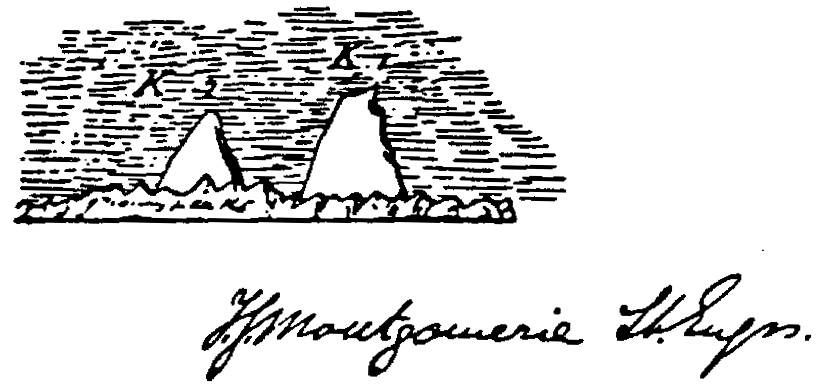|
List Of Mountains In Pakistan
Pakistan is home to 108 peaks above 7,000 metres and 4555 above 6,000 m. There is no count of the peaks above 5,000 and 4,000 m. Five of the 14 highest independent peaks in the world (the eight-thousanders) are in Pakistan (four of which lie in the surroundings of Concordia; the confluence of Baltoro Glacier and Godwin Austen Glacier). Most of the highest peaks in Pakistan lie in the Karakoram mountain range (which lies almost entirely in the Gilgit–Baltistan region of Pakistan, and is considered to be a separate range from Himalayan range) but some peaks above 7,000 m are included in the Himalayan and Hindu Kush ranges. Moreover, Pakistan is home to over 7,000 glaciers, more than anywhere except the polar regions. Considerations The list is an incomplete list of mountains in Pakistan. There are many named and unnamed peaks in Pakistan that are currently not included in this list. The list also includes many peaks that are not usually classed as independent mountains, but ... [...More Info...] [...Related Items...] OR: [Wikipedia] [Google] [Baidu] |
Nanga Parbat The Killer Mountain
Nanga may be: *Nanga (instrument), an Egyptian musical instrument *Nanga (Japanese painting) *Nanga Brook, Western Australia *Nanga of Kongo, second ruler or manikongo of the Central African kingdom of Kongo *Nanga subcaste of the Sial (tribe) in Pakistan *N'anga, name of African traditional healer in Zimbabwe See also *Nanga Parbat (other) **Nanga Parbat (), a mountain in Azad Kashmir, Pakistan; ninth highest in the world {{disambig ... [...More Info...] [...Related Items...] OR: [Wikipedia] [Google] [Baidu] |
Tirich Mir
Terich Mir (also spelled Terichmir, Tirich Mir and Turch Mir) is the highest mountain of the Hindu Kush range, and the highest mountain in the world outside of the Himalayas–Karakoram range, at above sea level. It is located in the Chitral District of Khyber Pakhtunkhwa, Pakistan. It is the 33rd highest peak in the world. The first recorded ascent of the mountain was on 21 July 1950 by a Norwegian-British expedition consisting of Arne Næss, P. Kvernberg, H. Berg, and Tony Streather, depicted in the 1952 documentary film '' Tirich Mir til topps''. Tirich Mir overlooks the town of Chitral, and can be easily seen from the main bazaar. It is the highest mountain in the province of Khyber Pukhtunkhwa. In fact, it is the highest mountain of Pakistan outside the Gilgit-Baltistan region. The last village situated in Chitral District before the mountain begins is the village of Tirich. This valley begins at Soorwaht, where Tirich River meets Torkhow River from the west, up ... [...More Info...] [...Related Items...] OR: [Wikipedia] [Google] [Baidu] |
7 15 BroadPeak
7 (seven) is the natural number following 6 and preceding 8. It is the only prime number preceding a cube. As an early prime number in the series of positive integers, the number seven has symbolic associations in religion, mythology, superstition and philosophy. The seven classical planets resulted in seven being the number of days in a week. 7 is often considered lucky in Western culture and is often seen as highly symbolic. Evolution of the Arabic digit For early Brahmi numerals, 7 was written more or less in one stroke as a curve that looks like an uppercase vertically inverted (ᒉ). The western Arab peoples' main contribution was to make the longer line diagonal rather than straight, though they showed some tendencies to making the digit more rectilinear. The eastern Arab peoples developed the digit from a form that looked something like 6 to one that looked like an uppercase V. Both modern Arab forms influenced the European form, a two-stroke form consisting of a ho ... [...More Info...] [...Related Items...] OR: [Wikipedia] [Google] [Baidu] |
Broad Peak
Broad Peak (; ) is one of the eight-thousanders, and is located in the Karakoram range spanning Gilgit-Baltistan, Pakistan and Xinjiang, China. It is the 12th highest mountain in the world with elevation above sea level. The first ascent of this mountain was in June 1957, accomplished by Fritz Wintersteller, Marcus Schmuck, Kurt Diemberger, and Hermann Buhl as part of an Austrian expedition. Geography Broad Peak is part of the Gasherbrum massif in Baltistan situated on the border of Pakistan and China. It is located in the Karakoram mountain range, approximately from K2. The peak's name aptly describes its physical characteristics, with a summit that extends over 1.5 kilometers (7⁄8 miles) in length, giving it the appearance of a "broad peak." Three of the mountain's five summits are eight-thousanders: Broad Peak (8051 m), Rocky Summit (8028 m), Broad Peak Central (8011 m), with Broad Peak North (7490 m), and Kharut Kangri (6942 m) being th ... [...More Info...] [...Related Items...] OR: [Wikipedia] [Google] [Baidu] |
Gasherbrum I
Gasherbrum I, originally surveyed as K5, and also known as Hidden Peak, is the 11th highest mountain in the world at above sea level. It is located between Shigar District in the Gilgit–Baltistan region of Pakistan and Tashkurgan in the Xinjiang province of China. Gasherbrum I is part of the Gasherbrum Massif, located in the Karakoram region of the Himalaya. ''Gasherbrum'' is often claimed to mean "Shining Wall", presumably a reference to the highly visible face of the neighboring peak Gasherbrum IV; but in fact, it comes from "rgasha" (beautiful) + "brum" (mountain) in Balti, hence it actually means "beautiful mountain". Gasherbrum I was designated K5 (meaning the 5th peak of the Karakoram) by T.G. Montgomerie in 1856 when he first spotted the peaks of the Karakoram from more than 200 km away during the Great Trigonometric Survey of India. In 1892, William Martin Conway provided the alternate name, Hidden Peak, in reference to its extreme remoteness, due to whic ... [...More Info...] [...Related Items...] OR: [Wikipedia] [Google] [Baidu] |
Fairy Meadows And The View Of Nanga Parbat
A fairy (also called fay, fae, fae folk, fey, fair folk, or faerie) is a type of mythical being or legendary creature, generally described as anthropomorphic, found in the folklore of multiple European cultures (including Celtic, Slavic, Germanic, and French folklore), a form of spirit, often with metaphysical, supernatural, or preternatural qualities. Myths and stories about fairies do not have a single origin but are rather a collection of folk beliefs from disparate sources. Various folk theories about the origins of fairies include casting them as either demoted angels or demons in a Christian tradition, as deities in Pagan belief systems, as spirits of the dead, as prehistoric precursors to humans, or as spirits of nature. The label of ''fairy'' has at times applied only to specific magical creatures with human appearance, magical powers, and a penchant for trickery. At other times, it has been used to describe any magical creature, such as goblins and gnomes. ''Fair ... [...More Info...] [...Related Items...] OR: [Wikipedia] [Google] [Baidu] |
Chogori
K2, at above sea level, is the List of highest mountains on Earth, second-highest mountain on Earth, after Mount Everest at . It lies in the Karakoram, Karakoram range, partially in the Gilgit-Baltistan region of Pakistan-administered Kashmir and partially in the China-administered Trans-Karakoram Tract in the Taxkorgan Tajik Autonomous County of Xinjiang. Quote: "K2 is located in the Karakoram Range and lies partly in a Chinese-administered enclave of the Kashmir region within the Uygur Autonomous Region of Xinjiang, China, and partly in the Gilgit-Baltistan portion of Kashmir under the administration of Pakistan." K2 became known as the ''Savage Mountain'' after George Irving Bell, George Bell—a climber on the 1953 American Karakoram expedition, 1953 American expedition—said, "It's a savage mountain that tries to kill you." Of the five highest mountains in the world, K2 has long been the deadliest: prior to 2021, approximately one person had died on the mountain for ... [...More Info...] [...Related Items...] OR: [Wikipedia] [Google] [Baidu] |
Mountain Range
A mountain range or hill range is a series of mountains or hills arranged in a line and connected by high ground. A mountain system or mountain belt is a group of mountain ranges with similarity in form, structure, and alignment that have arisen from the same cause, usually an orogeny. Mountain ranges are formed by a variety of geological processes, but most of the significant ones on Earth are the result of plate tectonics. Mountain ranges are also found on many planetary mass objects in the Solar System and are likely a feature of most terrestrial planets. Mountain ranges are usually segmented by highlands or mountain passes and valleys. Individual mountains within the same mountain range do not necessarily have the same geologic structure or petrology. They may be a mix of different orogenic expressions and terranes, for example thrust sheets, uplifted blocks, fold mountains, and volcanic landforms resulting in a variety of rock types. Major ranges Most geolo ... [...More Info...] [...Related Items...] OR: [Wikipedia] [Google] [Baidu] |
Prominence
In topography, prominence or relative height (also referred to as autonomous height, and shoulder drop in US English, and drop in British English) measures the height of a mountain or hill's summit relative to the lowest contour line encircling it but containing no higher summit within it. It is a measure of the independence of a summit. The key col ("saddle") around the peak is a unique point on this contour line and the ''parent peak'' (if any) is some higher mountain, selected according to various criteria. Definitions The prominence of a peak is the least drop in height necessary in order to get from the summit to any higher terrain. This can be calculated for a given peak in the following manner: for every path connecting the peak to higher terrain, find the lowest point on the path; the ''key col'' (or ''highest saddle'', or ''linking col'', or ''link'') is defined as the highest of these points, along all connecting paths; the prominence is the difference between the ... [...More Info...] [...Related Items...] OR: [Wikipedia] [Google] [Baidu] |
Elevation
The elevation of a geographic location (geography), ''location'' is its height above or below a fixed reference point, most commonly a reference geoid, a mathematical model of the Earth's sea level as an equipotential gravitational equipotential surface, surface (see Geodetic datum#Vertical datum, Geodetic datum § Vertical datum). The term ''elevation'' is mainly used when referring to points on the Earth's surface, while ''altitude'' or ''geopotential height'' is used for points above the surface, such as an aircraft in flight or a spacecraft in orbit, and ''three-dimensional space, depth'' is used for points below the surface. Elevation is not to be confused with the distance from the center of the Earth. Due to the equatorial bulge, the summits of Mount Everest and Chimborazo (volcano), Chimborazo have, respectively, the largest elevation and the largest ECEF, geocentric distance. Aviation In aviation, the term ''elevation'' or ''aerodrome elevation'' is defined by the IC ... [...More Info...] [...Related Items...] OR: [Wikipedia] [Google] [Baidu] |
List Of Highest Mountains On Earth
There are at least 108 mountains on Earth with elevations of or greater above sea level. Of these, 14 are more than . The vast majority of these mountains are part of either the Himalayas or the Karakoram mountain ranges located on the edge of the Indian Plate and Eurasian Plate in China, India, Nepal, and Pakistan. Discussion The dividing line between a mountain with multiple peaks and separate mountains is not always clear (see also Highest unclimbed mountain). A popular and intuitive way to distinguish mountains from subsidiary peaks is by their height above the highest saddle connecting it to a higher summit, a measure called topographic prominence or re-ascent (the higher summit is called the "parent peak"). A common definition of a mountain is a summit with prominence. Alternatively, a relative prominence (prominence/height) is used (usually 7–8%) to reflect that in higher mountain ranges everything is on a larger scale. The table below lists the highest 100 summit ... [...More Info...] [...Related Items...] OR: [Wikipedia] [Google] [Baidu] |





